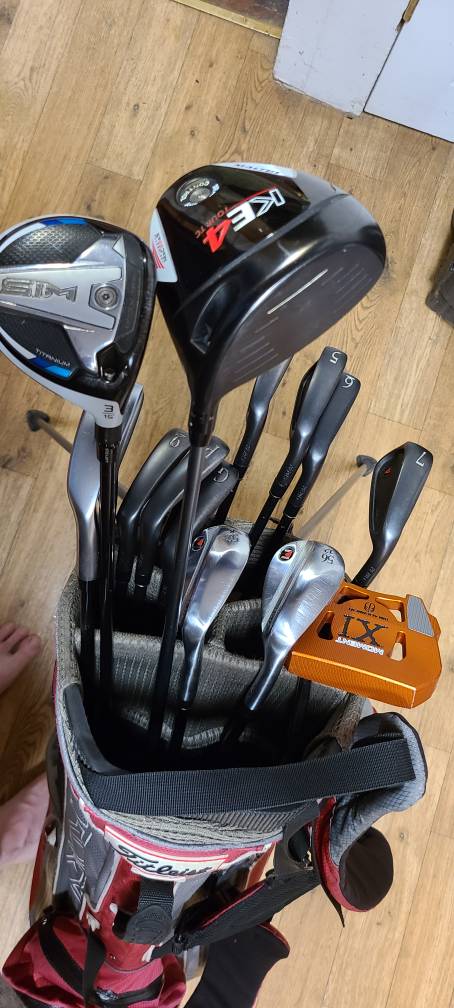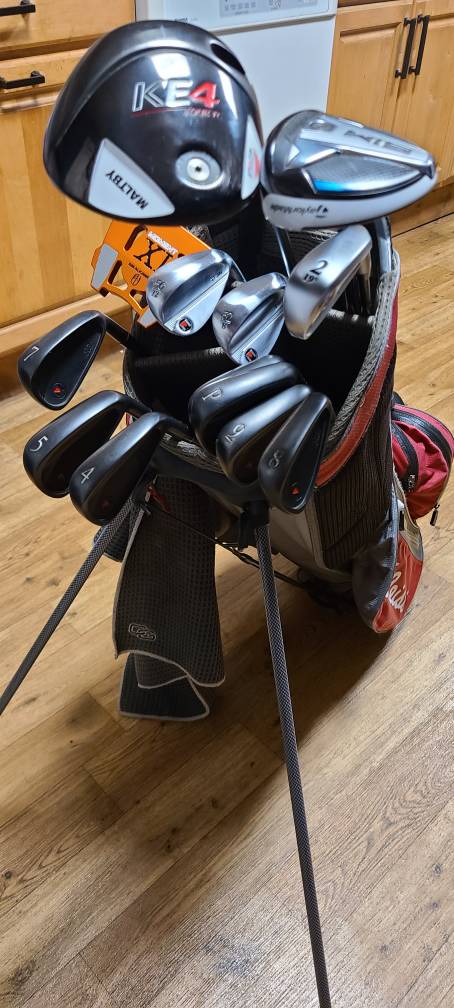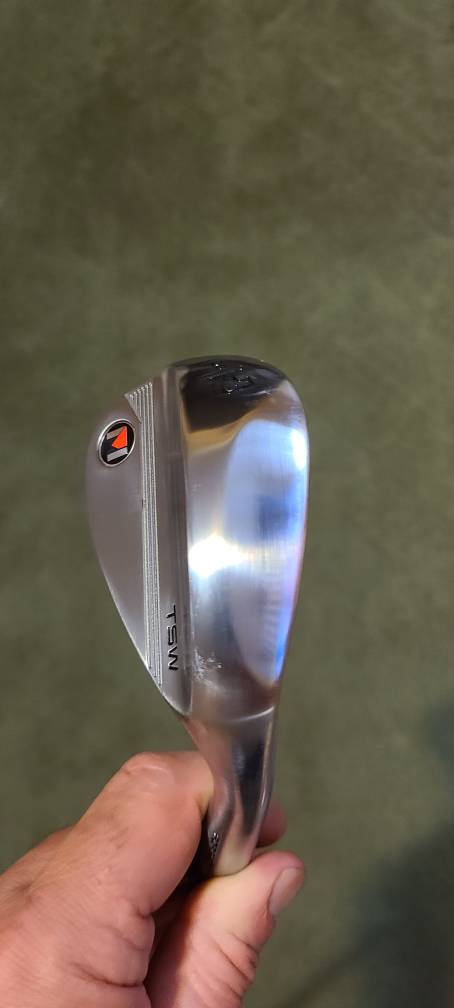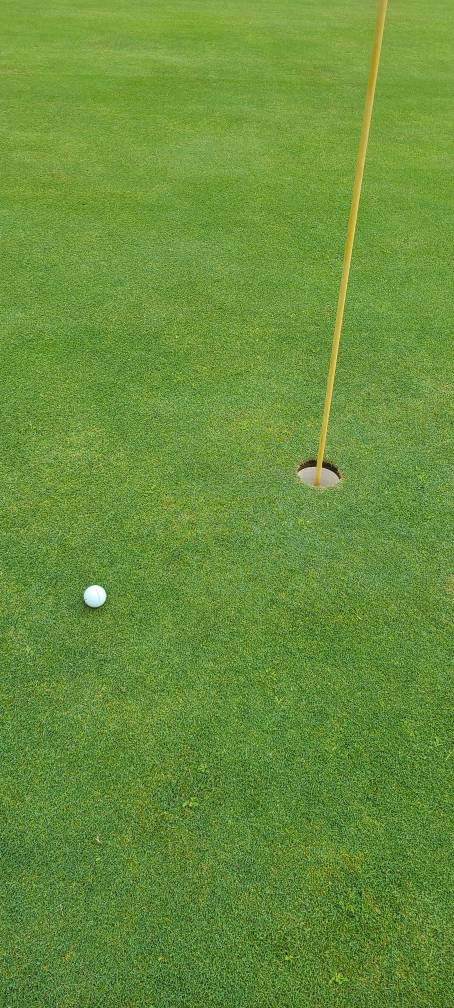
Popeye64
Member-
Posts
460 -
Joined
-
Last visited
Content Type
Profiles
Forums
Articles
FAQ
Tests
Classifieds
Store
Group Buys
Everything posted by Popeye64
-
Here is current bag. Ke4 TC- Xcaliber T6 ☆ S TM SIM 3w Ti- Xcaliber Rapid Taper Fw FDI 2 HY- Xcal Rapid Taper 75 g PTM BLACKS 4-Gw- Xcal Pro X 85g TSW 52-56- Xcal Spin Wedge 100g shaft Ball is the amazing Bridgestone Tour B X. Easily the best bag I've had in such a long time. Sent from my SM-G981U using Tapatalk
-
Nice bag. How is that shaft working out for you? Sent from my SM-G981U using Tapatalk
-
So I took the late plunge on these because I had a set of Xcaliber Spin Wedge shafts on the way. After all these years I have never tinkered with them. I ordered the 52 and the 56. First off they are flat out sexy. Such a classy looking wedge. Simple graphics and understated looks. Its a surprisingly compact head as well. First go round at a ramge with gnarly grass left me with a,,, oh wow. These are horrible.. feeling. Couldn't find the face. Struggled through the cabbage and just had no feel. Even a buddy didn't like them. So today I just got home from sea and took a chance and brought these out. Right from the first green I hit a tight chip to save a bogey. Things were looking up. Starting on the back nine they got a workout. They were so instinctive and easy to play. The sole has a definite rocker to them that I would set the wedge down right upon that rocker. It felt right. Gave me confidence that I wouldn't hit it fat. The wedge would glide through the turf. Taking a tiny divot but each time catching the ball very cleanly With the spin wedge shafts the spin was a plenty. I was stopping the ball alot more quickly than my M+ gamers. They also go a good 5 yards further same loft. On full shots they really dance upon the green. They dont rip back but they certainly dance. They were certainly fun to play. These shafts are 100g S flex and they are fairly stout. I might even want to try the R flex as I like a little more give to my wedge. With that said these performed really well. I honestly can't complain about them feeling firm as I wound up with 5 birdies on the back. Finished at -2 as on the front side i caught up with the league and the final 4 holes took a month to finish. For the first time out I was very surprised at how these played like I've been gaming them for ever. Huge fan of the sole and how it sits on the ground. For a wedge I thought I was gonna hate this one is a standout. The last picture is why I made 5 birdies in 7 holes. I may put a Spin Wedge in my PTM GW. To gain a little more gap as its only about 5-6 yards with the 52 TSW now... Sent from my SM-G981U using Tapatalk
-
Like anything, once you get some time with lighter shafts you quickly get used to how they feel. Now when i swing a 125 or a 130g shaft it feels like a cinder block. Sent from my SM-G981U using Tapatalk
-
I was always on the heavier side till I did a 3 weight shaft study. 85, 95 and 105g shafts. I had 8 better players including me. Every one of them swore they couldn't hit the 85 at all. Yet every one of them. Hit it farther. Hit it straighter. Hit it more consistently. They still said they preferred their heavier weighted shafts but couldn't explain the better performance away. Many golfers are convinced they must play heavier shafts. Right now the Xcaliber 75g Rapid Tapers are being produced and I'm doing a lot of player testing. I simply hand them the club and won't tell them what it weighs. They marvel at the feel, launch and the near perfect spin numbers without ballooning. They will tell me it does feel lite, they can feel the club head, it is responsive and controlled. When they hear how much it weighs they make a funny face and say its too light. Then they hit another 10 shots down range straight as an arrow. The less weight obviously doesn't do well for better player when you get to wedges. But slower swings do exceptionally well. Players are slowly realizing that shafts built today don't have to be 130g to perform. Sent from my SM-G981U using Tapatalk
-
Earlier this season I was doing a driver head comparison between Taylormade SIM head and a Maltby KE4 TC. They had identical shafts in length and CPM. Superlite55 Xcaliber shafts. On three separate days I collected data. The KE4 spun on average 2-300 rpms less. But nearly all other data was identical and only separated by a mph here or a yard there. The KE4 technically beat out the SIM but it was splitting hairs. As the testing went on i found the SIM to be much more consistent once I got it outside. But from what i saw the variations of spin from shot to shot creates marginal changes. I believe a 500 rpm change would be needed to really impact Joe Average player. Then when you become more comfortable with any said club you find out what works and what doesn't. So then if you went back and collected data again the numbers would change quite a bit. The SIM has been my testing head for the past three months. As I became more familiar with it I was able to improve all aspects of data. And we all know how our swing can change from week to week if not day to day. 500+/- would be needed for a true impact I believe. Sent from my SM-G981U using Tapatalk
-
Then go crazy with it and see what you learn. Sent from my SM-G981U using Tapatalk
-
Tipping an inch will make a noticeable difference but not in a huge way. It will stiffen the shaft but it wont make much of a change in flight characteristics. I understand you are hoping to change flight shape but tipping will only do so much. I do recommend experimenting though. Tip it an inch and see what you get. You may be able to get away with the shorter playing length. Or if you have enough parallel tip section tip it 1.5" and add some to the butt. Going all the way to 2" can be a bit extreme. The shaft doesnt work for you so tinkering with it wont hurt it. Sent from my SM-G981U using Tapatalk
-
Take a good look at the Xcaliber Pro X iron shafts. They are the ideal transition shaft for the player that has to switch to graphite because of age and a beat up body. They are a graphite shaft with a metal woven mesh blended into the shaft. Acts like steel, dampens like graphite and distance of graphite. Its a shaft i have been playing with for years. 85g and 95g versions. The Avalon i8 and i9 are the Pro X to another level. Both versions are very stable and consistent. Zoom in on the picture and you can see the woven meah. Sent from my SM-G981U using Tapatalk
-
If you are struggling with a shaft choice simply grab the stock club pak. The TT Score LT will get the job done quite nicely for not much money. Sent from my SM-G981U using Tapatalk
-
Great explanation of what a wedge is to you. Sent from my SM-G981U using Tapatalk
-
If any of you guys are building clubs with any regularity you need to check out the banner on the website. Even just having access to the new Rapid Taper shafts would make it worth while. 25% discount too. Sent from my SM-G981U using Tapatalk
-
I added a 52 and a 56 to an order I had in. Looking forward to these. Sent from my SM-G981U using Tapatalk
-
If you dont know about Maltby clubs log on to the Golfworks.c9m site and do a little shopping. Read the reviews and find a club that suits you. They even have a custom shop that can build you anything. The will fit your budget but they are anything but budget clubs. They have clubs for beginners to Tour players. Best deal in golf by a mile. Sent from my SM-G981U using Tapatalk
-
I see a lot of guys asking how to line up the factory shaft orientation lines. Shafts that are marked have a white line and a red line 90° of each other. Here is a good read from Robin Arthur. White and Red Lines on the XCaliber Shafts When the factory does the first QC/QA check for butt frequency (stiffness) they are instructed to find the most stable plane (perfect oscillation) using the Auditor frequency machine (i.e. no "wobbling"/out of plane movement). That plane is then measured and if within the shaft’s specification tolerances (+/- 2/3 cpm), is marked w/ a WHITE line - a "poor man's PURing" if you will. The shaft is then rotated 90 deg. and again checked that it is w/in that shaft’s specification tolerances. It doesn't necessarily have to have "perfect motion", but it's normally pretty close. That plane is then marked w/ a RED line. This step then insures rotational consistency as we don't want a shaft that is very stiff in one plane, then a LOT weaker in another. That may cause out-of-plane bending under load/during a swing – not a good attribute for consistent bending during a golf swing. The WHITE line is then rotated 90 degrees counter-clockwise, or in the ball flight direction for a right-handed golfer. This rotation automatically brings the RED line to the top, or perhaps at 0 degrees. So, now we have the most stable plane aligned to the flight direction of a golf ball. Countless hours of testing has shown… It WORKS!!! A Brief Discussion on Frequency Testing Historically throughout the years, the stiffness of a golf shaft was measured by simply securing the butt end of a shaft (called “cantilever”) and then suspending a weight at the tip end of a shaft and measuring how far it bended (was deflected) - the more deflection, the weaker the shaft. This method of determining shaft stiffness was limited in that it was actually measuring the sum total of all the incremental points of stiffness from tip end to butt end of the shaft. Imagine 2 shafts with the same degree of bend. One shaft could be stiff at both the upper and lower sections, and weak in the middle section. A second shaft could be very weak at the lower section, but stiff in the upper and middle sections. Can you see why these two shafts could play completely different yet have the same deflection? Enter the measurement methodology called frequency. Frequency was originally thought to be a better method of measuring shafts because it was a “dynamic” test – meaning the shaft was “moving” or in this case oscillating up and down. Those cycles were read by an optic sensor and read as “cycles per minute” or CPM. This technique though advanced was still reading the summation of all the incremental stiffness referred to above. To make a long story short, while at Grafalloy I started looking at incremental stiffness along the length of a golf shaft using a test procedure that basically measured what is called EI Curves. To obtain an EI Curve, measurements are taken every 2” for the full length of a shaft. A graph of the stiffness measurements (profile) along the entire length of a shaft could now be visually seen. Back to the 2 shafts above. Although having the same butt stiffness, now we could see and quantify “how” did they arrive at the same deflection or cpm values. Further, the performance of these two shafts could be better understood because of this distribution of stiffness (and the same is true for weight, torque, etc.). Because of the complexity and cost of the testing for EI Curves, Britt and I were members of a Team that established a simpler method call Zone Frequency – an invaluable tool in the design and testing process. It’s like knowing how a car engine works, and what need to be done to make it run even better. Sent from my SM-G981U using Tapatalk
-
For myself I would prefer the long range weapon from the turf as opposed to a tee only three wood. Sent from my SM-G981U using Tapatalk
- 10 replies
-
Ill take this statement even further. Every match play event I've played in with strokes given... i would get matched up with an 18 or so that was no where near an 18.. maybe a 10-12. Their blowup holes would give me an easy win. But thats about it. Maybe other people have come across true Handicaps but not in my case. Sent from my SM-G981U using Tapatalk
-
Wilson Staff Irons at Goodwill
Popeye64 replied to toehold57's topic in Club Making/Repair & DIY Projects
You should also follow that ping eye 2 auction below them. Sent from my SM-G981U using Tapatalk -
I will say that the pressure of match play with handicaps is on the scratch player. Scratch has to be perfect. Stepping up to a par 3 where you are giving strokes is a prime example of where the pressure is truly on. A higher hp can get on a roll with a string of pars and just kill you. I also found one of the biggest things with match play is to never give up on a hole. You never know what the other guy will stumble on. Grind out every hole. With that said try not to pay attention to what he is doing. Play the hole like you are in a bubble and stay to your strengths. I do like your format of playing where ever you can. Sent from my SM-G981U using Tapatalk
-
I have trouble watching him and enjoy his blow up holes. With the amount of time he takes to hit a putt I would have a problem playing in his group... not that I would have that problem anyways. Sent from my SM-G981U using Tapatalk
-
SIM ti 3 wood head only is inbound. Picked it up for some shaft testing. Needed the changeable hosel. Nice excuse..... Sent from my SM-G981U using Tapatalk
-
On a well struck shot the ICON 8 iron vs the PTX 8 iron should go the same distance. They may do it at different launch angles due to COG differences but distamce will be negligible. Now a poorly struck ICON might not go as far as a PTX given the more forgiving nature of the PTX. I've seen on a lainch monitor a tour style player get better efficiency out of a Miura blade vs his own set with identical lofts on pure shots... But hit that Miura a little thin or on the toe and the penalty was harsh. I would expect the same out of the Hogan's. Sent from my SM-G981U using Tapatalk
-
With the wider sole there is much more effective bounce. This isn't designed as a wedge you could shave with. The relieved edge and generous sole make it super playable. If you need more of a players wedge the Tour MG is the one. Sent from my SM-G981U using Tapatalk
-
They are actually being built now. Will be a little while before they are ready for retail. The TS-2, I could hit that with a baby draw and it was stupid long. Actually when it got down the the 9i and GW they went simply too far for me. Sent from my SM-G981U using Tapatalk
-
I have to say.. thats a really nice looking wedge. Sent from my SM-G981U using Tapatalk








.jpg.bf83325cd64cfce19331f26b05772567.jpg)